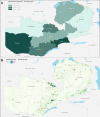Initial implementation of PrEP in Zambia: health policy development and service delivery scale-up
- PMID: 34244265
- PMCID: PMC8273462
- DOI: 10.1136/bmjopen-2020-047017
Initial implementation of PrEP in Zambia: health policy development and service delivery scale-up
Abstract
Introduction: Daily pre-exposure prophylaxis (PrEP) for HIV prevention is highly effective, but not yet widely deployed in sub-Saharan Africa. We describe how Zambia developed PrEP health policy and then successfully implemented national PrEP service delivery.
Policy development: Zambia introduced PrEP as a key strategy for HIV prevention in 2016, and established a National PrEP Task Force to lead policy advocacy and development. The Task Force was composed of government representatives, regulatory agencies, international donors, implementation partners and civil society organisations. Following an implementation pilot, PrEP was rolled out nationally using risk-based criteria alongside a national HIV prevention campaign.
National scale-up: In the first year of implementation, ending September 2018, 3626 persons initiated PrEP. By September 2019, the number of people starting PrEP increased by over sixfold to 23 327 persons at 728 sites across all ten Zambian provinces. In the first 2 years, 26 953 clients initiated PrEP in Zambia, of whom 31% were from key and priority populations. Continuation remains low at 25% and 11% at 6 and 12 months, respectively.
Lessons learnt: Risk-based criteria for PrEP ensures access to those most in need of HIV prevention. Healthcare worker training in PrEP service delivery and health needs of key and priority populations is crucial. PrEP expansion into primary healthcare clinics and community education is required to reach full potential. Additional work is needed to understand and address low PrEP continuation. Finally, a task force of key stakeholders can rapidly develop and implement health policy, which may serve as a model for countries seeking to implement PrEP.
Keywords: HIV & AIDS; health policy; public health.
© Author(s) (or their employer(s)) 2021. Re-use permitted under CC BY-NC. No commercial re-use. See rights and permissions. Published by BMJ.
Conflict of interest statement
Competing interests: None declared.
Figures





Similar articles
-
Programme science in action: lessons from an observational study of HIV prevention programming for key populations in Lusaka, Zambia.J Int AIDS Soc. 2024 Jul;27 Suppl 2(Suppl 2):e26237. doi: 10.1002/jia2.26237. J Int AIDS Soc. 2024. PMID: 38982890 Free PMC article.
-
Addressing the Need for a Preexposure Prophylaxis Monitoring and Evaluation Implementation Guide: Experience From Zambia.Glob Health Sci Pract. 2023 Apr 28;11(2):e2200396. doi: 10.9745/GHSP-D-22-00396. Print 2023 Apr 28. Glob Health Sci Pract. 2023. PMID: 37116937 Free PMC article. Review.
-
Initial implementation of HIV pre-exposure prophylaxis for people who are incarcerated in Zambia: a cross-sectional observational study.Lancet HIV. 2023 Jan;10(1):e24-e32. doi: 10.1016/S2352-3018(22)00220-X. Epub 2022 Oct 13. Lancet HIV. 2023. PMID: 36243018
-
Lessons learnt from daily oral PrEP delivery to inform national planning for PrEP ring introduction for women in low-income and middle-income countries: a qualitative inquiry of international stakeholders.BMJ Glob Health. 2024 May 7;9(5):e014709. doi: 10.1136/bmjgh-2023-014709. BMJ Glob Health. 2024. PMID: 38770814 Free PMC article.
-
The preexposure prophylaxis revolution; from clinical trials to programmatic implementation.Curr Opin HIV AIDS. 2016 Jan;11(1):80-6. doi: 10.1097/COH.0000000000000224. Curr Opin HIV AIDS. 2016. PMID: 26575147 Free PMC article. Review.
Cited by
-
Factors associated with awareness of and willingness to use PrEP among stable, heterosexual HIV-serodifferent couples in seven African countries, 2019-2022.J Int AIDS Soc. 2025 Jun;28(6):e26446. doi: 10.1002/jia2.26446. J Int AIDS Soc. 2025. PMID: 40534141 Free PMC article.
-
Creating allies: qualitative exploration of young women's preferences for PrEP methods and parents' role in PrEP uptake and user support in urban and rural Zambia.BMC Womens Health. 2024 Jan 25;24(1):71. doi: 10.1186/s12905-024-02913-7. BMC Womens Health. 2024. PMID: 38273282 Free PMC article.
-
Programme science in action: lessons from an observational study of HIV prevention programming for key populations in Lusaka, Zambia.J Int AIDS Soc. 2024 Jul;27 Suppl 2(Suppl 2):e26237. doi: 10.1002/jia2.26237. J Int AIDS Soc. 2024. PMID: 38982890 Free PMC article.
-
Disseminating Evidence-Based Interventions for Adolescent HIV Treatment and Prevention in Sub-Saharan Africa.AIDS Behav. 2023 May;27(Suppl 1):64-72. doi: 10.1007/s10461-022-03794-3. Epub 2022 Sep 27. AIDS Behav. 2023. PMID: 36166109 Free PMC article.
-
Integrated HIV and STIs response: Trends in syphilis incidence and uptake of oral pre-exposure prophylaxis in Zambia.J Public Health Afr. 2025 Jul 10;16(1):1306. doi: 10.4102/jphia.v16i1.1306. eCollection 2025. J Public Health Afr. 2025. PMID: 40799377 Free PMC article.
References
-
- WHO . Guideline on when to start antiretroviral therapy and on pre-exposure prophylaxis for HIV, 2015. - PubMed
Publication types
MeSH terms
Substances
Grants and funding
LinkOut - more resources
Full Text Sources
Medical
Miscellaneous
